Recent Posts
Understanding the Diverse Damage Caused by Wind Storms
1/4/2024 (Permalink)
Wind storms, characterized by powerful gusts and turbulent winds, have the potential to unleash a variety of damages that can impact both the immediate surroundings and, in some cases, extend over large areas. From structural damage to environmental changes, the effects of wind storms can be diverse and far-reaching. In this blog, we'll delve into the various types of damage that wind storms can cause, highlighting the importance of preparedness and proactive measures in mitigating their impact.
Structural Damage
One of the most evident and often severe consequences of wind storms is structural damage to buildings and infrastructure. High winds can tear off roof shingles, break windows, and even lead to the collapse of weaker structures. Ensuring the structural integrity of homes and buildings is crucial in minimizing the potential harm.
Wind storms have the capability to turn everyday objects into dangerous projectiles. Loose items such as branches, signs, and outdoor furniture can become projectiles, causing damage to structures, vehicles, and posing a threat to personal safety.
Power Outages
The force of strong winds can bring down power lines and utility poles, leading to widespread power outages. Extended periods without electricity can disrupt daily life, compromise communication systems, and pose risks to vulnerable populations, emphasizing the importance of having contingency plans in place.
Trees, while providing natural beauty and shade, can become casualties of wind storms. High winds can break branches, uproot trees, or even topple them entirely. This not only poses a risk to nearby structures but also creates hazards for pedestrians and motorists.
Fires and Floods
In wind storms, power lines or electrical equipment damaged by fallen trees or debris can lead to fires. The combination of high winds and fire poses a serious threat to communities, necessitating swift response and effective firefighting measures.
Wind storms, especially those associated with hurricanes or typhoons, can bring about storm surges and intense rainfall, leading to flooding in coastal and low-lying areas. This flood water can cause extensive damage to homes, businesses, and infrastructure.
Tornado Formation
Wind storms may spawn tornadoes, which are highly destructive and have the potential to cause significant damage in localized areas. Tornadoes can demolish structures, uproot trees, and toss debris over considerable distances.
In arid regions, wind storms can result in the suspension of dust and debris in the air, reducing visibility and creating respiratory hazards. This phenomenon, known as a haboob, can have adverse effects on both the environment and public health.
Infrastructure Vulnerability
Critical infrastructure, such as bridges, dams, and communication towers, may face vulnerability during wind storms. Ensuring the resilience of such structures is essential for maintaining the functionality of essential services.
Businesses are not immune to the impacts of wind storms. Structural damage, power outages, and supply chain disruptions can lead to financial losses and business interruptions, underscoring the importance of robust contingency plans.
Understanding the multifaceted nature of damage caused by wind storms is crucial for effective preparedness and response. From reinforcing structures to implementing resilient urban planning, communities can take proactive measures to mitigate the impact of wind storms and enhance their ability to navigate the aftermath. By prioritizing safety, communication, and environmental stewardship, we can build resilience in the face of nature's formidable forces and work towards creating more robust, storm-ready communities.
Resurrecting from the Ashes: Restoring Fire-Damaged Electronics and Appliances
11/27/2023 (Permalink)
Fires can cause extensive damage to properties, including electronics and appliances. The intense heat, smoke, and water used to extinguish fires can render these items inoperable or severely damaged. However, with the help of professionals and specialized techniques, fire-damaged electronics and appliances can often be restored. In this blog, we will explore the process of restoring fire-damaged electronics and appliances and the steps involved in their recovery.
Assessment and Safety Precautions
Before any restoration work begins, it is crucial to have a professional assess the extent of the damage to the electronics and appliances. This assessment determines whether restoration is feasible or if replacement is necessary. Additionally, safety precautions must be taken, such as ensuring the electricity supply is turned off and that there are no electrical hazards present.
Cleaning and Decontamination
The restoration process for fire-damaged electronics and appliances involves thorough cleaning and decontamination. Soot, smoke, and other fire-related residues can accumulate and cause damage to internal components, as well as leaving behind unpleasant odors. Specialized cleaning techniques, such as ultrasonic cleaning, can be used to remove these residues and restore functionality.
Drying and Moisture Removal
If the electronics or appliances have been exposed to water during firefighting efforts, it is essential to dry them thoroughly. Moisture can cause further damage and corrosion. Professionals may use drying techniques such as air circulation, dehumidification, or even vacuum drying to remove excess moisture effectively.
Repairs and Components Replacement
In some cases, fire-damaged electronics and appliances may require repairs or parts replacements. Trained technicians can identify the damaged components and replace them, restoring functionality. This may involve sourcing specific parts or working with manufacturers to ensure compatibility.
Electrical Testing and Safety Checks
Once the restoration and repairs are complete, thorough electrical testing and safety checks are performed to ensure the electronics and appliances are safe to use. This ensures proper grounding, verifies that all components are functioning correctly, and ensures compliance with electrical safety standards.
Professional Restoration vs. DIY Approach
Restoring fire-damaged electronics and appliances is a specialized process that requires expertise and specialized equipment. While some minor issues may be fixable through DIY approaches, it is generally recommended to seek professional assistance. Professionals have the necessary knowledge and experience to handle damaged electronics safely and effectively, minimizing the risk of further damage or potential hazards.
Fire damage can be devastating, impacting electronics and appliances in homes or businesses. However, with the help of trained professionals in restoration techniques, these items can often be salvaged and restored to their pre-fire condition. Through thorough assessment, cleaning, repairs, and electrical safety checks, fire-damaged electronics and appliances can once again be functional. If you're faced with fire-damaged electronics or appliances, reach out to restoration experts who can help resurrect these valuable items from the ashes.
Understanding the Basics of Mold: A Comprehensive Guide
10/26/2023 (Permalink)
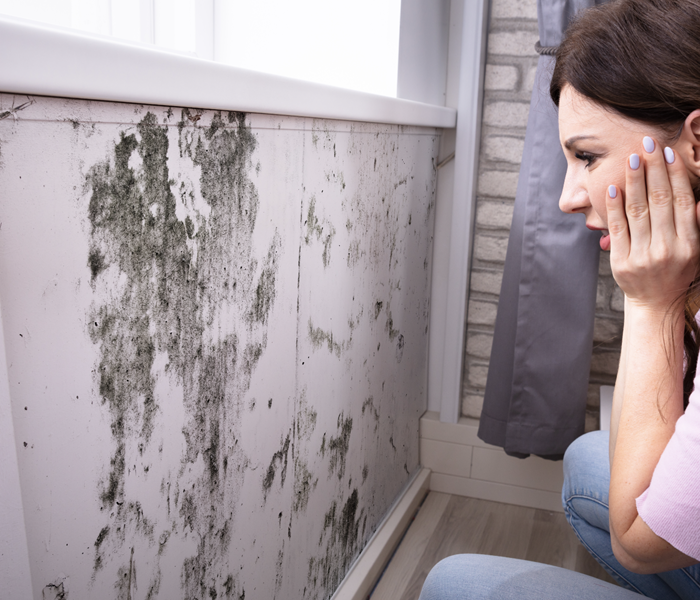 Understanding the basics of mold is crucial to ensure your home is safe.
Understanding the basics of mold is crucial to ensure your home is safe.
Mold is a common issue that many homeowners encounter, but understanding its basics can help you better address mold-related concerns. In this comprehensive guide, we will explore the fundamentals of mold. By providing clear information, we aim to help you comprehend the nature of mold and equip you with knowledge to prevent and manage mold-related issues in your home.
What is Mold?
Mold is a type of fungus that thrives in damp environments. It appears as discoloration on surfaces, typically green, black, or white. Mold grows and spreads by releasing tiny spores into the air, which can settle and thrive in suitable conditions. While mold itself is not harmful, it can indicate the presence of excess moisture that may lead to structural damage or other issues if left unaddressed. Understanding mold's characteristics helps in effectively managing its growth.
Common Causes of Mold Growth
Mold growth is triggered by factors such as water leaks, high humidity, condensation, or flooding. Areas with inadequate ventilation, like bathrooms or basements, are particularly prone to mold growth. Mold can also develop on organic materials like wood or paper if they become damp. Identifying and addressing the source of moisture is key to preventing mold growth, as it needs moisture to survive.
Signs and Detection of Mold
Detecting mold early is important in order to take necessary actions. Signs of mold include visible discoloration on surfaces, a musty odor, or an increase in allergic reactions or respiratory issues. Regularly inspecting areas prone to moisture, such as basements, crawl spaces, and bathrooms, can help in identifying mold growth. Remember, mold can also be hidden within walls or under carpets, so careful examination may be required.
Preventing and Controlling Mold Growth
Preventing mold growth starts with effective moisture control. Fix any plumbing leaks promptly and address areas with excessive moisture or high humidity levels. Ensure proper ventilation in bathrooms, kitchens, and other moisture-prone areas. Use dehumidifiers or moisture-absorbing products to reduce humidity if necessary. Regular cleaning and drying of damp areas and materials also help in preventing mold growth.
Managing Mold Problems
If you discover mold in your home, taking appropriate measures to manage the issue is crucial. Small mold patches can often be cleaned with a mixture of detergent and water, followed by thorough drying. Larger or persistent mold infestations may require professional assistance to ensure effective and safe removal. Regular monitoring and maintenance of moisture levels can help prevent future mold problems.
Recognizing the Importance of Regular Maintenance
Regular maintenance plays a vital role in mold prevention and management. It is essential to address any potential moisture issues promptly, fix leaks, and keep surfaces dry. Inspect your home regularly, paying attention to areas prone to moisture, and take immediate action if you detect any signs of mold growth. By practicing proactive maintenance, you can minimize the risk of mold becoming a recurring problem and ensure a healthier and more comfortable living environment for you and your family.
By comprehensively understanding the basics of mold you can approach mold-related issues with confidence. Empowered with knowledge on mold characteristics, detection, prevention, and management, you can proactively create a mold-free living environment for you and your family. Remember, prompt action is essential to prevent mold growth from causing further damage in your home.
Water Damage Prevention in High-Risk Areas: Basements, Attics, and Crawl Spaces
10/23/2023 (Permalink)
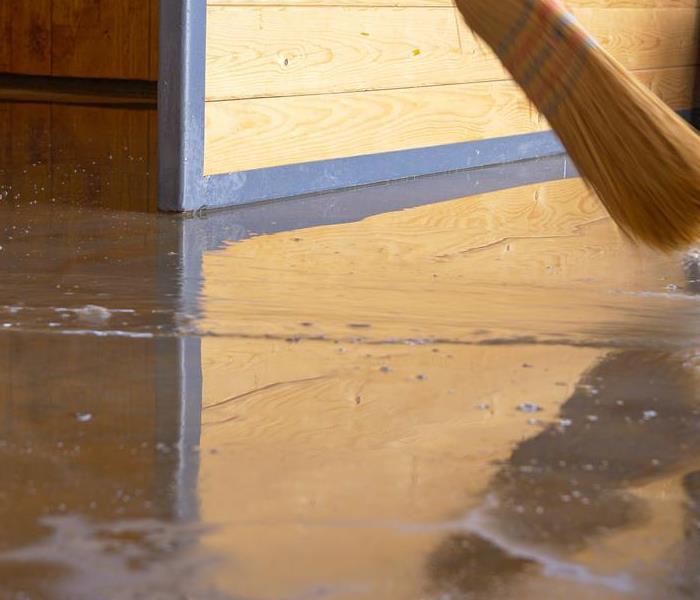 Prevention is key to ensure your home is free from a water loss.
Prevention is key to ensure your home is free from a water loss.
Water damage can wreak havoc on our homes, causing structural damage, mold growth, and costly repairs. Certain areas of our homes are more susceptible to water damage, namely basements, attics, and crawl spaces. These areas are often overlooked when it comes to preventive measures, making them prime targets for water infiltration. In this blog post, we will discuss effective strategies to prevent water damage in these high-risk areas.
Basements
Basements are notorious for water intrusion issues due to their below-ground level and proximity to groundwater. Here are some preventive measures to protect your basement:
- Ensure proper exterior grading around your home's foundation. The ground should slope away from your foundation, allowing rainwater to drain away instead of pooling near the basement walls.
- Foundation Sealing. Regularly inspect your basement's foundation for cracks or gaps that could allow water to seep in. Seal any vulnerabilities using appropriate waterproof sealants or coatings to create a barrier against water infiltration.
- Sump Pump Install a reliable sump pump system in your basement. A sump pump helps drain excess water away from your home's foundation, reducing the risk of basement flooding. Ensure proper maintenance and occasional testing to ensure it functions reliably when needed.
- Interior Waterproofing. Consider waterproofing measures such as installing a waterproofing membrane or sealant on basement walls. This extra layer of protection can help prevent water from entering and damaging your basement, Attics are often susceptible to water damage caused by leaky roofs or condensation issues. Consider the following preventive measures to safeguard your attic.
Roof Inspection and Maintenance
Regularly inspect your roof for any signs of damage, such as missing or damaged shingles. Promptly repair any issues to prevent water from seeping through the roof into the attic. Keep your gutters clean and free from debris to ensure proper water drainage.
Attic Ventilation
Ensure proper ventilation in your attic to reduce condensation buildup. Install vents or fans to promote air circulation, preventing moisture accumulation that could lead to mold growth and water damage. Consider insulating your attic appropriately to prevent temperature fluctuations that may cause condensation.
Inspect Plumbing
Check for any plumbing lines or pipes running through your attic. Insulate these pipes to prevent them from freezing and bursting during colder months, which can cause extensive water damage. Crawlspaces are often neglected areas that can become breeding grounds for moisture-related issues. Here's how you can protect your crawlspace from water damage:
Vapor Barrier
- Install a vapor barrier on the ground in your crawlspace. A vapor barrier helps prevent groundwater or soil moisture from evaporating into the crawlspace area, reducing the risk of dampness and mold growth.
- Proper Ventilation. Ensure adequate ventilation and airflow in your crawlspace to reduce moisture buildup. Install vents or fans in strategic locations to promote air circulation and prevent excess humidity.
- Foundation Insulation: Insulate the walls of your crawlspace to create a thermal barrier. Proper insulation helps maintain consistent temperatures, preventing condensation and reducing the risk of water damage.
Routinely check your crawlspace for signs of leaks, water intrusion, or moisture-related issues. Promptly address any problems to prevent further damage. Prevention is always the best defense against water damage. By implementing these preventive measures in your basement, attic, and crawlspace, you can significantly reduce the risk of water infiltration and protect your home from the damaging effects of water. Regular inspections, timely repairs, and appropriate maintenance are essential to maintaining a dry and safe living environment.
Assessing Wind Damage After the Storm: What to Look For
9/28/2023 (Permalink)
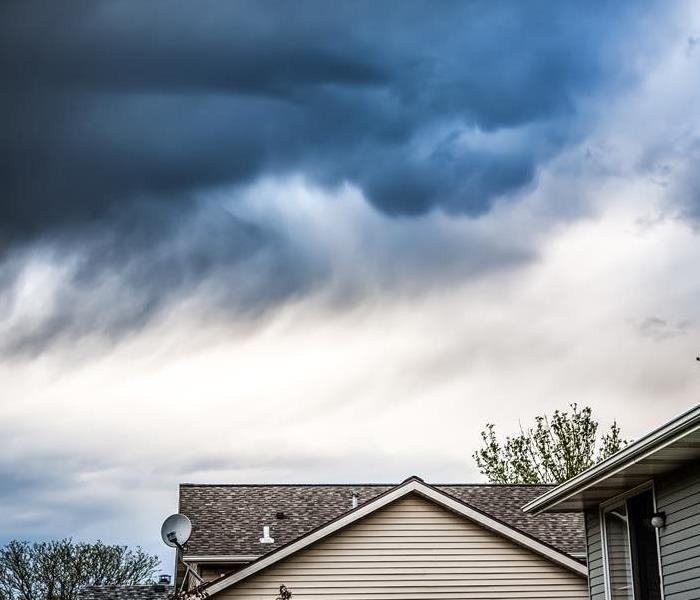 Promptly assess and address wind damage to ensure your property is safe after a storm
Promptly assess and address wind damage to ensure your property is safe after a storm
Wind damage is a common consequence of storms in the South Central region. Whether it's a hurricane, tornado, or severe thunderstorm, strong winds can wreak havoc on homes, buildings, and landscapes. After a storm passes, it's important to assess the damage to ensure the safety of your property and plan for necessary repairs. In this blog post, we will discuss what to look for when assessing wind damage after a South Central storm.
Roof Damage
Inspect your roof for signs of damage caused by strong winds. Look for missing or lifted shingles, cracked or broken tiles, or any visible gaps in the roof structure. Pay attention to areas around chimneys, vents, and skylights, as they are common entry points for wind-driven rain. Additionally, check your gutters and downspouts for debris or signs of detachment, as they play a crucial role in diverting water away from your home.
Windows and Exteriors
Check your windows and doors for any visible damage. Strong winds can cause windows to crack, shatter, or become dislodged from their frames. Inspect the caulking around windows and doors for any gaps or signs of wear, which can lead to water infiltration during storms. Test your doors to ensure they open and close properly, as excessive wind pressure can cause misalignment or damage to the hinges and frames.
Examine the exterior of your home or building for any damage to the siding or walls. Look for loose or missing siding panels, dents, cracks, or holes. Inspect the corners, edges, and seams for any signs of separation or damage. Wind can cause siding to become dislodged or compromised, which can lead to water penetration and further structural damage if not addressed promptly.
Trees and Outdoor Structures
Assess the impact of the storm on trees and your landscape. Check for fallen or uprooted trees, broken branches, and damaged vegetation. Fallen trees can cause extensive damage to structures and pose safety risks, so it's crucial to address them promptly. If you notice any leaning or weakened trees on your property, contact a certified arborist to evaluate their stability and recommend appropriate actions.
Inspect fences, decks, and other outdoor structures for wind damage. Look for signs of leaning, loose or missing boards, broken fasteners, or any structural compromise. High winds can weaken these structures, potentially making them unsafe to use. Assess the stability and integrity of your fences, decks, pergolas, and sheds to ensure they are capable of withstanding future storms.
Power Lines and Utilities
Exercise caution when inspecting the area around power lines and utilities, as they pose a significant safety risk. If you notice any downed power lines or damaged utility infrastructure, report it to the appropriate authorities immediately and keep a safe distance. Do not attempt to touch or move any electrical equipment or wires yourself.
Professional Assessment
While a visual inspection can help you identify obvious wind damage, it's a good idea to consult with a professional, such as a licensed contractor or building inspector, for a more thorough assessment. They can identify hidden or structural damage that may not be immediately noticeable to the untrained eye. A professional assessment can also provide a more accurate estimation of repair costs and ensure that all necessary repairs are properly addressed.
Assessing wind damage after a South Central storm is essential for the safety and restoration of your property. Carefully inspect your roof, windows, doors, siding, trees, and outdoor structures for any signs of damage. Ensure that any downed power lines or utility damage is reported to the appropriate authorities. For a comprehensive assessment, consider consulting with a professional who can provide expert advice and guidance on repair options. By promptly assessing and addressing wind damage, you can protect your property and ensure its resilience against future storms.
Essential Safety Tips for Fire Prevention
8/19/2023 (Permalink)
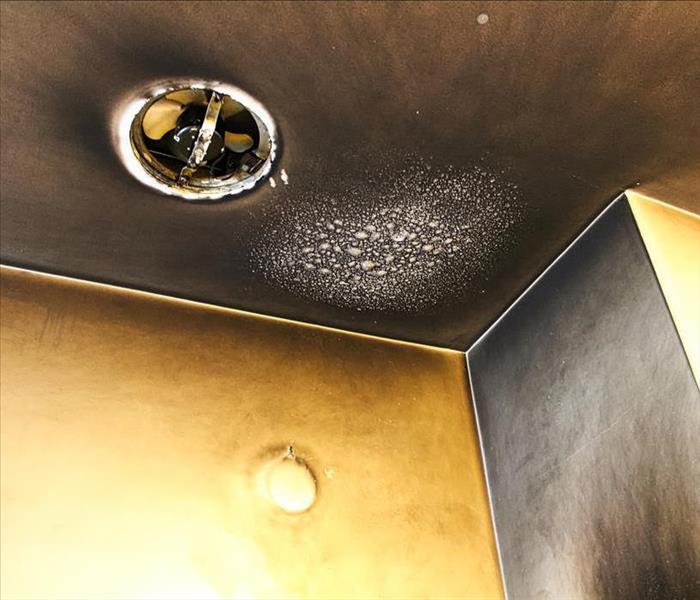 Preventing fires in your home and business requires a combination of awareness, caution, and preparedness.
Preventing fires in your home and business requires a combination of awareness, caution, and preparedness.
Fires can be devastating, causing significant damage to property and posing a threat to lives. However, with proper fire prevention measures in place, you can greatly reduce the risk of fire in your home and business. In this blog post, we will discuss essential tips to help you prevent fires and keep your environment safe.
Install Smoke Alarms
Start by installing smoke alarms in every bedroom, outside each sleeping area, and on every level of your home or business. Regularly test and maintain them to ensure they are in proper working order. Smoke alarms are crucial for early detection and can save lives by providing valuable time to evacuate.
Place fire extinguishers in easily accessible locations throughout your home and business. Make sure they are suitable for the specific types of fires that may occur in your surroundings (e.g., Class A, B, C, or K) and that they are labeled and certified. Train yourself and others on how to use them correctly.
Practice Electrical Safety
- Avoid overloading electrical outlets and extension cords.
- Inspect your electrical cords regularly and replace any that are frayed or damaged.
- Don't run electrical cords under rugs or furniture.
- Follow the manufacturer's guidelines for your electrical devices and appliances, and avoid using them beyond their recommended capacity.
- Consider hiring a professional electrician for any electrical work or upgrades.
Practice Kitchen Safety
Never leave cooking unattended.
Keep flammable items away from heat sources.
Clean grease and food debris regularly from stovetops, ovens, and exhaust hoods.
Have a fire extinguisher specifically designed for kitchen fires (Class K) nearby.
If a grease fire occurs, never use water to extinguish it; instead, use a lid to smother the flames.
Be Cautious with Candles and Smoking
Keep candles away from flammable materials and never leave them unattended.
Ensure candles are extinguished before leaving the room or going to bed.
If smoking, always extinguish cigarettes completely and dispose of them safely.
Properly Store Flammable Materials
Store flammable liquids (such as gasoline, paint thinner, or cleaning solvents) in properly labeled and approved containers away from ignition sources.
Keep them in well-ventilated areas and away from heat or flame.
Develop an Emergency Plan
Educate everyone in your household or business about fire safety. Teach children about the dangers of fire and what to do in case of an emergency. Conduct regular fire drills and training sessions to ensure everyone knows how to respond.
Create and practice a fire escape plan for your home and business, including designated meeting points. Ensure all family members and employees are aware of the escape plan.
Other tips include:
- Install escape ladders for upper floors, if necessary.
- Have your heating systems, chimneys, and vents inspected and cleaned annually.
- Replace filters regularly and maintain proper clearance around heating equipment.
- Keep flammable materials and combustible waste in designated containers away from heat sources.
- Dispose of ashes from fireplaces or stoves in metal containers, never in plastic or paper bags.
Preventing fires in your home and business requires a combination of awareness, caution, and preparedness. By implementing these essential fire prevention tips, you can significantly reduce the risk of fires and protect yourself, your loved ones, and your property. Remember, fire safety is a shared responsibility, so encourage everyone around you to practice these preventive measures and be vigilant in fire prevention. Stay safe!
Causes, Risks, and Prevention of Secondary Water Damage
8/10/2023 (Permalink)
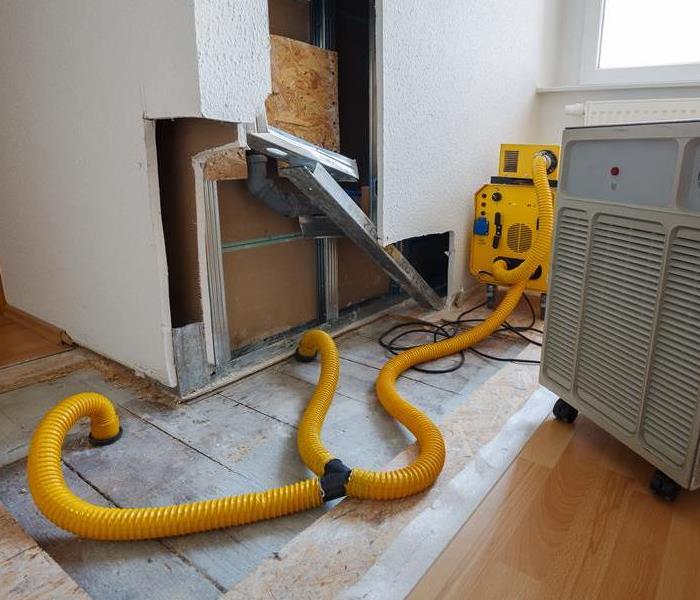 Preventing secondary damages after a water loss is essential to prevent further damage.
Preventing secondary damages after a water loss is essential to prevent further damage.
Water damage is a distressing experience for any homeowner or property owner. It not only causes immediate damage but can also lead to secondary issues that may worsen over time if left unaddressed.
Secondary water damage refers to the additional harm that occurs after the initial water intrusion, often resulting from prolonged exposure to moisture or inadequate restoration efforts. In this blog post, we will delve into the causes, risks, and prevention of secondary water damage to help you understand the importance of comprehensive restoration.
Causes of Secondary Water Damage
Excess moisture and high humidity levels in the affected area can lead to the growth of mold and mildew. These microbial organisms thrive in damp environments and can cause health issues while further damaging the structure and belongings.
Extended exposure to water can weaken the structural integrity of building materials such as drywall, wood, and insulation. This can lead to warping, buckling, and even collapse if the damage is severe. Structural damage requires costly repairs and can compromise the safety of the property.
Risks of Secondary Water Damage
- Increased Restoration Costs
Addressing secondary water damage often requires more extensive restoration efforts and can result in higher costs. Mold remediation, structural repairs, and other corrective measures are not only time-consuming but can also disrupt your daily life or business operations.
- Extended Restoration Timeline
Failure to address secondary water damage promptly can lead to a prolonged restoration process. This can disrupt your living or working environment, causing inconvenience and potential financial losses.
Prevention of Secondary Water Damage
After experiencing water damage, it is crucial to remove standing water and dry out the affected area as quickly as possible. Employ professional water extraction techniques and utilize high-powered drying equipment to mitigate moisture and humidity.
Ensure that all affected surfaces, including walls, floors, and furniture, are thoroughly dried to prevent lingering moisture. This may involve the use of dehumidifiers, fans, and proper ventilation. Pay attention to hidden areas and hard-to-reach spaces that are prone to moisture buildup.
- Professional Restoration Services
Engage the services of a reputable water damage restoration company with expertise in handling both primary and secondary damage. These professionals have the knowledge, experience, and equipment to effectively address water damage, mitigate secondary issues, and restore your property to its pre-damage condition.
Actively prevent mold growth by addressing water damage promptly. Properly dry out affected areas, discard severely damaged materials, and conduct mold remediation if necessary. Regularly inspect your property for signs of mold growth and promptly address any issues.
Understanding the concept of secondary water damage is crucial for effective water damage restoration. By recognizing the causes and risks associated with secondary damage, you can take proactive measures to prevent its occurrence. Prompt action, thorough drying, and professional restoration services are essential in mitigating secondary water damage and ensuring a safe and healthy environment for your property and its occupants. Remember, comprehensive restoration is key to preventing long-term complications and minimizing the financial and health impacts of water damage.
Weighing the Options: DIY vs. Professional Mold Removal - Pros and Cons
5/21/2023 (Permalink)
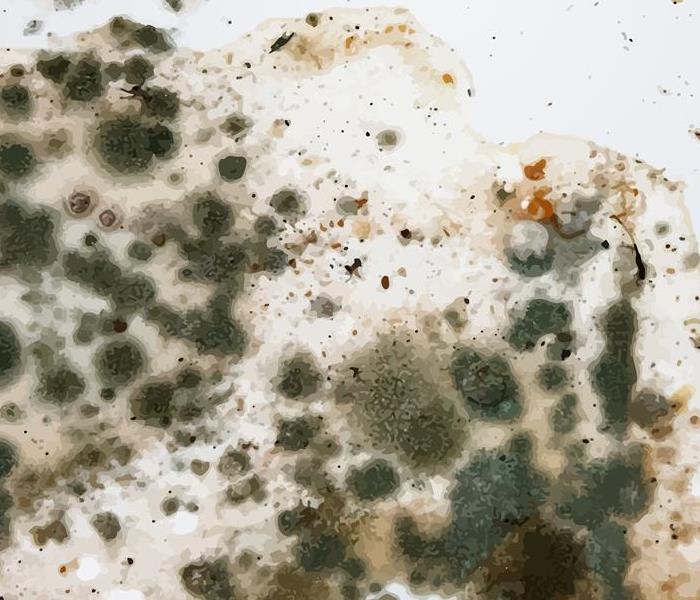 Choosing between DIY mold removal and hiring professionals depends on various factors.
Choosing between DIY mold removal and hiring professionals depends on various factors.
Mold growth can be a common issue in homes or businesses, leading to property damage and potential concerns. When faced with a mold problem, homeowners and business owners often wonder whether to tackle it themselves or hire a professional. In this blog, we'll explore the pros and cons of DIY mold removal versus hiring a professional service, helping you make an informed decision that suits your situation.
Pros of DIY Mold Removal
Cost Savings: One of the primary reasons homeowners opt for DIY mold removal is to save money. DIY methods typically involve purchasing cleaning solutions and equipment, which can be more affordable compared to professional services.
Immediate Action: With DIY mold removal, you can begin addressing the issue promptly. You have the flexibility to choose when and how to address the problem, which can be beneficial if you want to start the removal process immediately.
Small-Scale Mold Problems: DIY mold removal may be suitable for small-scale mold issues that are localized and easily accessible. If the affected area is limited, and you are confident in your ability to handle the cleanup effectively, DIY could be a viable option.
Cons of DIY Mold Removal
Limited Expertise: Mold removal involves more than just wiping surfaces. It requires an understanding of mold species, proper containment, removal techniques, and preventive measures. DIY enthusiasts may lack the necessary knowledge and expertise to effectively handle complex mold situations.
Incomplete Removal: Improper mold removal can lead to lingering spores and hidden growth. DIY methods may not fully eliminate the problem, allowing mold to resurface later. Professionals, on the other hand, are trained to identify hidden mold and ensure thorough remediation.
Safety Risks: It's important to note that handling mold without proper precautions may expose individuals to potential hazards. Professional mold removal companies follow safety protocols and use protective gear to minimize risks during the process.
Pros of Professional Mold Removal
Expert Knowledge and Experience: Mold remediation specialists possess the expertise and experience to handle mold problems effectively. They can identify the root cause, assess the extent of the infestation, and employ appropriate techniques for safe and complete removal.
Comprehensive Solutions: Professional mold removal services provide comprehensive solutions that go beyond surface cleaning. They address underlying issues, such as moisture control, ventilation improvements, and preventive measures, to reduce the chances of mold recurrence.
Time and Stress Savings: Hiring professionals frees up your time and relieves the stress of handling the mold removal process. You can focus on other priorities while the experts efficiently handle the cleanup, ensuring thorough and efficient results.
Cons of Professional Mold Removal
Cost Consideration: Professional mold removal services come at a cost. The expense varies based on the extent of the mold problem and the services required. However, it's essential to weigh the potential long-term costs of incomplete DIY removal against the upfront investment in professional services.
Scheduling Constraints: Depending on availability and the severity of the mold issue, scheduling professional mold removal may require some flexibility. It's advisable to contact mold remediation companies in advance to discuss timelines and ensure prompt attention to your needs.
Choosing between DIY mold removal and hiring professionals depends on various factors, such as the scale of the problem, expertise, and cost considerations. While DIY methods can work for minor issues, professional mold removal offers comprehensive solutions and expertise that ensure effective and lasting results. Evaluate your specific situation and make an informed decision that prioritizes the well-being of your property.
5 Common Causes of Residential Fire Damage and How to Prevent Them
4/6/2023 (Permalink)
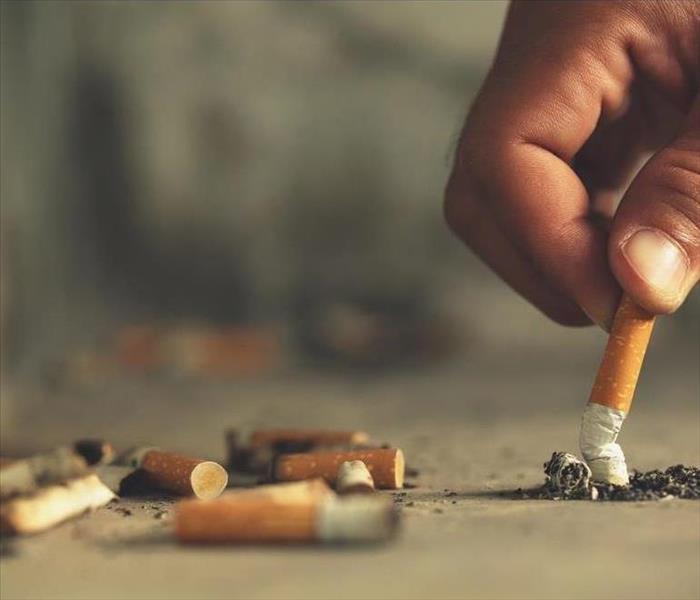 By understanding the common causes of fires and taking steps to prevent them, you can significantly reduce the risk of a fire occurring in your home.
By understanding the common causes of fires and taking steps to prevent them, you can significantly reduce the risk of a fire occurring in your home.
A house fire can be one of the most devastating events a homeowner can experience. Not only does it result in significant property damage, but it can also put the safety and well-being of you and your loved ones at risk. While some fires are caused by natural disasters or other uncontrollable events, many residential fires are preventable. By understanding the common causes of residential fire damage and taking steps to prevent them, you can significantly reduce the risk of a fire occurring in your home.
Cooking Accidents
Cooking is the leading cause of house fires, often resulting from unattended stovetops or cooking appliances. To prevent cooking-related fires, always stay in the kitchen while cooking, keep flammable materials away from the stove, and turn off appliances when finished cooking. Additionally, make sure that you have a fire extinguisher easily accessible in your kitchen and that you know how to use it in case of an emergency.
Electrical Malfunctions
Electrical fires can be caused by faulty wiring, overloaded circuits, or damaged electrical cords. To prevent electrical fires, have your home's electrical system inspected by a professional, avoid overloading outlets, and replace damaged cords or appliances immediately. It is also important to make sure that your electrical system is up to code and that any necessary repairs are made promptly.
Smoking
Smoking is a significant fire hazard, as cigarettes can easily ignite flammable materials. To prevent smoking-related fires, avoid smoking inside your home, use a deep ashtray, and always ensure that cigarettes are fully extinguished. Additionally, make sure that all smoking materials are kept away from flammable materials and that you do not smoke in bed or while drowsy.
Heating Equipment
Space heaters, furnaces, and other heating equipment can pose a serious fire risk if not used properly. To prevent heating-related fires, keep flammable materials away from heating equipment, use heating equipment that has been tested and certified by a recognized testing laboratory, and never leave heating equipment unattended. Additionally, make sure that all heating equipment is properly maintained and that any necessary repairs are made promptly.
Candles
Candles are a common cause of residential fires, often resulting from candles being left unattended or placed too close to flammable materials. To prevent candle-related fires, use flameless candles when possible, keep candles away from flammable materials, and never leave candles unattended. It is also important to make sure that all candles are extinguished before leaving a room or going to bed.
In addition to these preventative measures, it is important to have working smoke detectors throughout your home and to test them regularly to make sure that they are functioning properly. It is also a good idea to have a fire escape plan in place for you and your family, in case of an emergency. This should include identifying all possible exits from your home and establishing a meeting place outside of your home in case of a fire.
If a fire does occur in your home, it is important to prioritize your safety and evacuate the home immediately, calling 911 once you are outside.
By understanding the common causes of residential fire damage and taking steps to prevent them, you can significantly reduce the risk of a fire occurring in your home. Make sure that you are taking the necessary precautions to keep your home and family safe, and that you have a plan in place in case of an emergency.
Timing Is Everything When It Comes to Water Damage
3/6/2023 (Permalink)
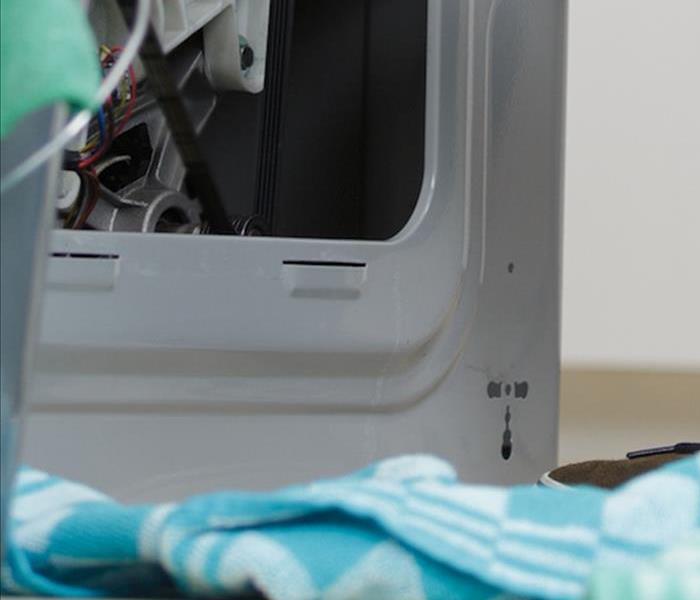 If your appliance causes water damage at your home, SERVPRO® of The Woodlands/Conroe can make the damage "Like it never even happened."
If your appliance causes water damage at your home, SERVPRO® of The Woodlands/Conroe can make the damage "Like it never even happened."
Water damage is a constant threat in our homes! Natural disasters and severe weather events can cause structural issues as well as water damage, and even something as simple as an appliance issue can leave you with a big mess on your hands.
Catching these issues quickly can help you avoid lasting damages.
An Appliance Malfunction
No one wants to think about it, but we all have nightmares of our appliances failing and causing a mess in our homes. In fact, it is one of the most common reasons for water damage among households in the Conroe community!
Any appliance that has a water line runs the risk of leaking or suffering some major malfunction.
If you notice a small drip coming from your washing machine or come home to a soaking wet carpet by your utility room, close off your water valves and turn off the power to any appliances near the water. Then give us a call! The faster we can respond to your emergency, the better chance you have of avoiding warped walls and floors and other costly damages.
Severe Weather and Flooding
Water damage can also occur due to any sort of weather event! When a severe storm rolls through town, it can cause flash flooding issues or lead to water backing up into your basement.
One way to avoid this is to invest in a sump pump for your lowest level. A sump pump works to pull water away from your foundation and basement, keeping your floors and walls nice and dry.
In addition, flying debris or a tornado can cause structural damage to your home, which can cause water damage if parts of your home are exposed to the elements.
In this scenario, make sure everyone in your family is safe and accounted for after the storm and then get us on the phone. Moisture can seep into many different areas, and the longer you wait to take action, you run the risk of mold and mildew on top of everything else.
How We Can Help
When it comes to water damage restoration, we know a thing or two! That is why our team should be your first phone call the moment you discover water damage anywhere in your home or property. We will work with you to create a full restoration plan, and then we will hit the road on our way to you.
We work hard to remove all of your fragile possessions and start by drying out as much of the water as we can. Our first goal is to save and recover as much as possible!
Once everything is removed, we bring in industry-leading drying equipment to make sure every inch of water is dried up. After that, we can address the necessary repairs and do whatever is required to return your home back to its pre-disaster state. We have your back no matter what water disaster you are facing.
Water can be very damaging to your home. Contact us for help with your recovery.





 24/7 Emergency Service
24/7 Emergency Service







